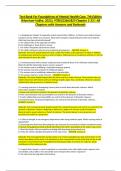Exam (elaborations)
Foundations of Mental Health Care, 7th Edition (Morrison-Valfre, 2021), 9780323661829 Chapter 1-33 | All Chapters with Answers and Rationals
- Course
- Institution
- Book
Foundations of Mental Health Care, 7th Edition (Morrison-Valfre, 2021), 9780323661829 Chapter 1-33 | All Chapters with Answers and Rationals
[Show more]



